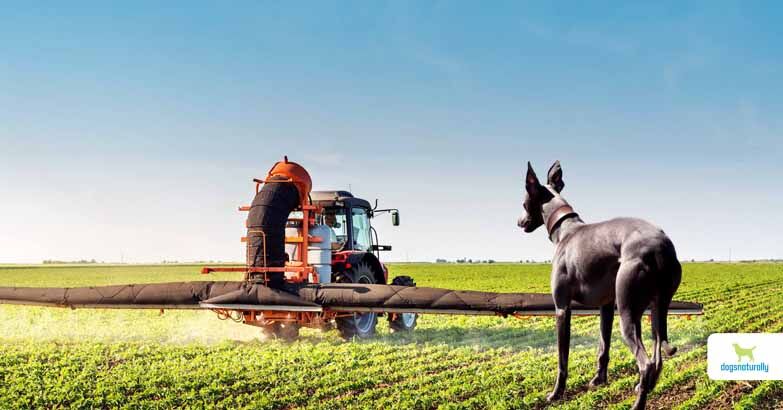If you feed kibble to your dog, it is almost certain that your furry friend is consuming chemical herbicides or pesticides at dinner. This is because kibbles often contain genetically modified (GM) ingredients such as corn, soy, canola, or alfalfa, which are grown with herbicides and pesticides. Or OWL foods (oats, wheat, legumes) that are harvested using glyphosate as a dessicant. And this is why there are pesticides in dog food.
GMOs are a controversial topic. Their safety has not been proven, and it is hard to find research confirming any negative effects. Most studies are funded by the companies that create GMOs.
Glyphosate, a widely used herbicide, has been detected in many pet foods, with significantly higher levels found in kibbles compared to raw pet foods. HRI Labs’ tests revealed kibble contained up to 660 ppb (parts per billion), while raw foods had only 5 ppb, and canned or freeze-dried foods tested at around 17 ppb.
Glyphosate is primarily excreted in urine, but studies have found it in dog urine at more than 30 times the level found in humans. This chemical has been associated with a range of health risks including cancer, liver and kidney damage, gut bacteria disruption leading to leaky gut and immune issues, endocrine disruption, digestive problems, allergies, and cognitive and behavioral issues. Often overshadowed by glyphosate is the genetically engineered Bt toxin, found in corn and soy genomes, which is potentially more harmful. Bt stands for Bacillus thuringiensis, a bacteria related to B anthracis, the cause of anthrax. While it’s used as a ‘safe’ pesticide in agriculture and organic farming, the altered Bt toxin can cause significant damage to a dog’s digestive system. Engineered plants can express up to six different Bt toxins, produce unique allergens, persist longer in the gut and environment, alter the microbiome, and act as endocrine disruptors. The GMO Bt gene, along with its adjuvants, can cause the Bt toxin to reproduce within the plant’s cells, leading to the formation of Bt factories in the intestines of animals that consume these plants. This can lead to continuous production of Bt and its persistence in the body for weeks after exposure. The adjuvants also stimulate the immune system to produce antibodies, potentially leading to food allergies and cancer. Known problems caused by Bt toxin include leaky gut, digestive issues, food poisoning, endocrine disruption, lung damage, and eye irritation or blindness. Lastly, agrochemicals are not used alone; they are formulated with ‘inert ingredients,’ which may not be as harmless as their name suggests. Adjuvants in glyphosate formulas have been found to be more toxic than glyphosate itself. Many tests conducted on glyphosate were actually on multi-ingredient formulas but did not disclose the presence of other chemicals.We really don’t understand the effects of long-term, low-level consumption of any of these compounds. Even organic products may not be entirely free of pesticides and herbicides spread by wind and rain, but at least they haven’t suffered direct application. So, organic products are a better choice than conventional crops.
Safer choices for dog food include freeze dried foods, some canned foods, and best of all is a raw diet, even if it’s made with factory-farmed meats. If you feed a raw or cooked homemade diet, pay attention to ingredients and choose organic if the produce is on the Environmental Working Group’s Dirty Dozen list of foods with the highest pesticide levels. How safe is your dog’s food? Visit dogfoodreviews.com to find out. References: Van Bruggen AHC, He MM, Shin K, Mai V, Jeong KC, Finckh MR, Morris JG Jr. Environmental and health effects of the herbicide glyphosate. Sci Total Environ. 2018 Mar;616-617:255-268. Are all forms of Bt toxin safe? BMO Science 2015 Aug 10 Benbrook CM. Trends in glyphosate herbicide use in the United States and globally. Environmental Sciences Europe. 2016; 28, 3. El-Shamei ZS, Gab-Alla AA, Shatta AA, Moussa EA, Rayan AM. Histopathological changes in some organs of male rats fed on genetically modified corn (Ajeeb YG). J Am Sci. 2012;8(10):684–696. Gab-Alla AA, El-Shamei ZS, Shatta AA, Moussa EA, Rayan AM. Morphological and biochemical changes in male rats fed on genetically modified corn (Ajeeb YG). J Am Sci. 2012;8(9):1117–1123. Dona A, Arvanitoyannis IS. Health risks of genetically modified foods. Crit Rev Food Sci Nutr. 2009 Feb;49(2):164-75. Temkin AM, Naidenko O. EWG tests of hummus find high levels of glyphosate weedkiller. Environmental Working Group. 2020 Jul 14. Klein K. Toxic Secret: Pesticides uncovered in store brand cereal, applesauce, beans and produce. Friends of the Earth. 2018. Then C, Bauer-Panskus A. Possible health impacts of Bt toxins and residues from spraying with complementary herbicides in genetically engineered soybeans and risk assessment as performed by the European Food Safety Authority EFSA. Environ Sci Eur. 2017;29(1):1. Wilcks A, Hansen BM, Hendriksen NB, Licht TR. Persistence of Bacillus thuringiensis bioinsecticides in the gut of human-flora-associated rats. FEMS Immunol Med Microbiol. 2006 Dec;48(3):410-8. Epub 2006 Nov 7. Frederiksen K, Rosenquist H, Jørgensen K, Wilcks A. Occurrence of natural Bacillus thuringiensis contaminants and residues of Bacillus thuringiensis-based insecticides on fresh fruits and vegetables. Appl Environ Microbiol. 2006 May;72(5):3435-40 Barfod KK, Poulsen SS, Hammer M, Larsen ST. Sub-chronic lung inflammation after airway exposures to Bacillus thuringiensis biopesticides in mice. BMC Microbiol. 2010 Sep 3;10:233. doi: 10.1186/1471-2180-10-233. Vázquez-Padrón RI, Moreno-Fierros L, Neri-Bazán L, et al. Characterization of the mucosal and systemic immune response induced by Cry1Ac protein from Bacillus thuringiensis HD 73 in mice.The Brazilian Journal of Medical and Biological Research published a study in 2000 that addressed the issue of adjuvant toxicity in commercial pesticides. The study, titled ‘Ignoring Adjuvant Toxicity Falsifies the Safety Profile of Commercial Pesticides’, highlights the importance of considering adjuvant toxicity when evaluating the safety of pesticides.
A more recent study by Mesnage R and Antoniou MN, published in Frontiers in Public Health on January 22, 2018, further emphasizes the significance of adjuvant toxicity in the context of pesticide safety. This research contributes to the understanding of how adjuvants can affect the overall toxicity of pesticides, which is crucial for accurate safety assessments.

